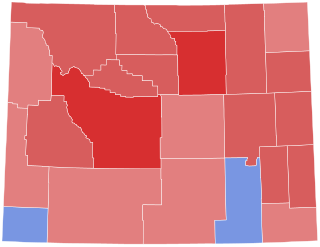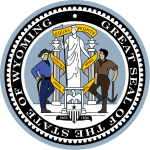
The 2006 Wyoming gubernatorial election took place on November 7, 2006. Incumbent Democratic Governor Dave Freudenthal won re-election in a landslide over Republican Ray Hunkins, becoming the first Democrat since 1910 to win every county in the state. To date this was the last time a Democrat was elected to statewide office in Wyoming, the last time a Democrat carried every county in the state, the last gubernatorial election in which a Democrat received more than 30% of the vote, and the last statewide election in which a Democrat won any county besides Teton, Albany, Laramie, or Sweetwater. As of 2024, Ray Hunkins is the last Republican gubernatorial nominee who was never elected Governor of Wyoming. This is the last time that Wyoming voted for and elected a Senate candidate and a gubernatorial candidate of different political parties.

Joseph Maull Carey was an American lawyer, rancher, judge, and politician, who was active in Wyoming local, state, and federal politics.

The 2010 Wyoming gubernatorial election was held on Tuesday, November 2, 2010, to elect the governor of Wyoming. Party primaries were held on August 17.

The 2002 Wyoming gubernatorial election was held on November 5, 2002. Incumbent Republican Governor Jim Geringer was term-limited and unable to seek a third term in office, thereby creating an open seat. Former U.S. Attorney Dave Freudenthal and former Wyoming House Speaker Eli Bebout both emerged from competitive Democratic and Republican primaries, respectively, and faced off against each other in the general election. Despite Wyoming's strong inclination to elect Republicans, a contentious race ensued, with Freudenthal ultimately defeating Bebout by fewer than 4,000 votes. As of 2025, this is the last gubernatorial election in Wyoming to be decided by less than 20 percentage points.

The 2014 Wyoming gubernatorial election was held on November 4, 2014, to elect the governor of Wyoming. The election coincided with elections to other federal and state offices.

The 1998 Wyoming gubernatorial election took place on November 3, 1998. Incumbent Republican Jim Geringer ran successfully for re-election to a second term as Governor of Wyoming, defeating Democratic nominee John Vinich.

The 2018 United States House of Representatives election in Wyoming was held on November 6, 2018, to elect the U.S. representative from Wyoming's at-large congressional district, who would represent the state of Wyoming in the 116th United States Congress. The election coincided with the 2018 U.S. mid-term elections, as well as other elections to the House of Representatives, elections to the United States Senate and various state and local elections.

The U.S. state of Wyoming is known for its reliably conservative politics and heavy support for the Republican Party, particularly in federal elections.

The 1994 Wyoming gubernatorial election took place on November 8, 1994. Incumbent Democratic Governor Mike Sullivan was unable to seek a third term because of newly imposed term limits, and instead ran for the U.S. Senate. State Senate President Jim Geringer won the Republican primary and faced Secretary of State Kathy Karpan, the Democratic nominee, in the general election. Aided by the nationwide Republican wave, Geringer defeated Karpan in a landslide, marking the first time since Governor Stanley Hathaway's re-election in 1970 that a Republican won a gubernatorial election in Wyoming.

The 1990 Wyoming gubernatorial election took place on November 6, 1990. Incumbent Democratic Governor Mike Sullivan ran for re-election. In the general election, he faced Republican nominee Mary Mead, a businesswoman and the daughter of former U.S. Senator and Governor Clifford Hansen. Owing to Sullivan's personal popularity, he won re-election over Mead in a landslide, marking the fifth straight Democratic victory in Wyoming's gubernatorial races, a streak that has yet to be broken by either party.

The 1986 Wyoming gubernatorial election took place on November 4, 1986. Popular three-term Democratic Governor Edgar Herschler announced that he would not seek a fourth term, creating an open seat. Attorney Mike Sullivan emerged as the unlikely Democratic nominee, and faced former state representative Pete Simpson, the Republican nominee and the brother of then-U.S. senator Alan K. Simpson, in the general election. Despite Sullivan's political inexperience, he was able to defeat Simpson by a decisive margin, winning his first of two terms in office.

The 1890 Wyoming gubernatorial election was held on September 11, 1890, as the first gubernatorial election for the newly admitted state of Wyoming. Incumbent Territorial Governor Francis E. Warren ran for re-election as the Republican nominee against former Territorial Governor George W. Baxter, the Democratic nominee. Warren defeated Baxter by a decisive margin and became the first popularly elected Governor of Wyoming.

The 1982 Wyoming gubernatorial election took place on November 2, 1982. Incumbent Democratic Governor Edgar Herschler ran for re-election to a third term. He faced former State House Speaker Warren A. Morton in the general election after several prominent Republicans, including then-Congressman Dick Cheney, declined to challenge him. However, Herschler remained personally popular and the national political environment favored Democrats, and he had little difficulty defeating Morton to win a third term. In doing so, Herschler became the first Governor of Wyoming to win three terms in office.

The 1958 Wyoming gubernatorial election took place on November 4, 1958. Incumbent Republican Governor Milward Simpson ran for re-election to a second term. He was challenged by John J. Hickey, the former U.S. Attorney for the District of Wyoming and the Democratic nominee. Following a close campaign, Hickey narrowly defeated Simpson for re-election, winning just a narrow plurality because of a third-party candidate in the race. In an irony, just four years later, in the 1962 special U.S. Senate election, Simpson would defeat Hickey, avenging his loss in the gubernatorial election. To date, this is the last time an incumbent Governor of Wyoming lost re-election.

The 1894 Wyoming gubernatorial election was held on November 6, 1894. Democratic Governor John E. Osborne, first elected in the 1892 special election, declined to seek re-election to a second term, instead aiming to be elected to the U.S. Senate. In part because of a backlash against the Democratic Party owing to the Panic of 1893, Republicans won the governorship back from the Democrats, and would hold onto it until 1914.

The 1906 Wyoming gubernatorial election was held on November 6, 1906. Incumbent Republican Governor Bryant B. Brooks ran for re-election to a second term. After winning renomination against some intraparty challengers, he faced State Senator Stephen Keister in the general election. Brooks was ultimately able to win re-election by an overwhelming margin, setting a record for the largest majority in a state gubernatorial election, which would not be exceeded until Governor Stanley Hathaway's re-election in 1970.

The 1934 Wyoming gubernatorial election took place on November 6, 1934. Incumbent Democratic Governor Leslie A. Miller ran for re-election to his second term, and his first full term, following his initial election in the 1932 special election. Miller faced Republican Alonzo M. Clark, his predecessor as governor, in the general election. Despite the closeness of Miller's first election, he took advantage of the nationwide Democratic landslide and easily defeated Clark.

The 1938 Wyoming gubernatorial election took place on November 8, 1938. Incumbent Democratic Governor Leslie A. Miller ran for re-election to his third term, and his second full term. Nels H. Smith, a former State Representative and former state highway commissioner, won a crowded Republican primary and advanced to the general election against Miller. Though Miller won his re-election campaign four years earlier in a landslide, Smith was able to take advantage of the nationwide Republican wave to defeat him in a landslide, winning 60% of the vote to Governor Miller's 40%.

The 2022 Wyoming gubernatorial election took place on November 8, 2022, to elect the governor of Wyoming. Incumbent Republican governor Mark Gordon won a second term against Democratic Wyoming State Facilities Commission member Theresa Livingston.

A general election was held in the U.S. state of Wyoming on Tuesday, November 3, 1914. All of the state's executive officers—the Governor, Secretary of State, Auditor, Treasurer, and Superintendent of Public Instruction—were up for election. Governor Joseph M. Carey declined to seek re-election to a second term, and Democratic State Senator John B. Kendrick was elected as his successor. Republicans, however, won all of the other statewide executive offices, including picking up the Superintendent's office.






















